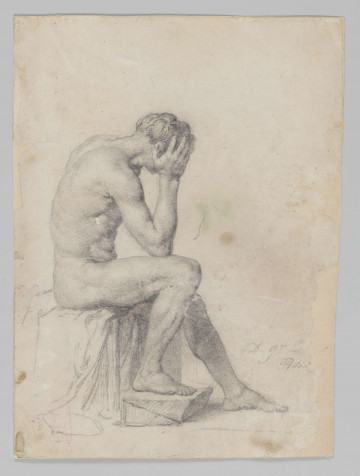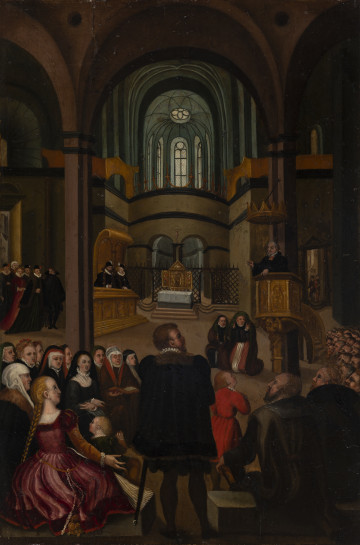
Male nude
National Museum in Lublin
Part of the collection: Polish symbolic painting from the beginning of the 20th c.
Edward Okuń was an artist gifted with particular imagination and artistic sensitivity. Based on classical principles of beauty, he developed a distinctive and original style of expression. In his modernistic and symbolist work, saturated with fairy-tale and mysteriousness, one can see inspirations with Italian Renaissance, Pre-Raphaelite painting and Art Nouveau aesthetics. In his decorative, atmospheric compositions, the artist drew on poetry and music, a typical practice in Symbolist circles. Allegorical visions showing the artist's fate represented by the figure of the violinist were a manifestation of the concept of the kinship of arts. A peculiar story about his sad fate, accompanied by incomprehension, loneliness, and often eternal oblivion, is told in about twenty years in the following paintings: Śmierć Paganiniego [Paganini’s Death], Filistrzy [The Philistines], Grajek [The Player], Mazurek Chopina [Chopin's Mazurkek], Cztery struny skrzypiec [Four Strings of a Violin].
The first work of this formally unplanned series from 1898 touches upon a fascinating problem connected with music – it poses the question about the genesis of talent and the mystery of inspiration. To depict the theme, the painter chose the story of the brilliant virtuoso and composer Niccolò Paganini. The Italian musician possessed such a unique and supernatural technical mastery of the violin that he was accused of conspiring with the devil. In exchange for his talent, he was to give up his soul. Okun's grim vision depicts the moment of Paganini's lonely death when the devil arrives to collect his payment. The scene depicted has a peculiar degree of intimacy. In an ascetic, gloomy interior, two figures are illuminated by bright moonlight streaming through a window. The figures and objects cast differently shaped shadows on the wall and floor. A demon sitting on the edge of the bed leans over the deceased so that the composer does not miss the sounds of the melody he is playing for him.
The second authorial title of the painting, Sen Paganiniego [Paganini's Dream], refers to another legend concerning the mysteries of artistic creation, i.e., the person of Giuseppe Tartini, the author of Sonata z diabelskim trylem [Sonata with a Devilish Trill]. As the composer maintained, it was supposed to have been written in unusual circumstances. In a dream, he had a musical duel with the devil, during which the infernal violinist played such a wonderful melody that Tartini decided to write it down. However, he noted down only its fragment. In the conception of the painting, Okuń used a 19th-century graphic illustration of this story.
Bożena Kasperowicz
Author / creator
Dimensions
cały obiekt: height: 134 cm, width: 184 cm
Object type
painting
Technique
oil technique
Material
canvas, oil-based paint
Creation time / dating
Creation / finding place
Owner
The National Museum in Lublin
Identification number
Location / status

National Museum in Lublin

1895
National Museum in Szczecin

3. ćwierć XVI wieku
National Museum in Szczecin
DISCOVER this TOPIC
Castle Museum in Łańcut
DISCOVER this PATH
Educational path